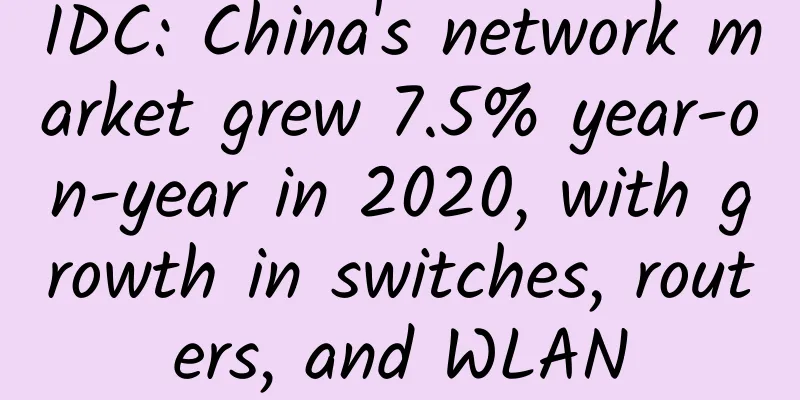Authoritative interpretation from the Ministry of Industry and Information Technology: What exactly is "5G+Industrial Internet"?

|
Recently, the Information and Communications Administration of the Ministry of Industry and Information Technology released the article "Encyclopedia Encyclopedia of "5G+Industrial Internet", which comprehensively interpreted the basic definition, development background, connotation composition, application scenarios, etc. of "5G+Industrial Internet". 1. Basic Definition"5G+Industrial Internet" refers to the use of new-generation information and communication technologies represented by 5G to build new infrastructure, application models and industrial ecology that are deeply integrated with the industrial economy. Through the comprehensive connection of people, machines, objects, systems, etc. through 5G technology, a new manufacturing and service system covering the entire industrial chain and the entire value chain is built, providing a new way to achieve the digitalization, networking and intelligent development of industry and even industries, helping enterprises to achieve cost reduction, quality improvement, efficiency increase, green and safe development. At present, a new round of scientific and technological revolution and industrial transformation is advancing by leaps and bounds, and information technology is changing with each passing day. The integration of 5G and the Industrial Internet will accelerate the construction of Digital China and Smart Society, accelerate the process of China's new industrialization, and inject new impetus into China's economic development. In the process of Digital China, Smart Society construction and new industrialization development, "5G+Industrial Internet" will mainly play a basic role, aggregating role, and integrating role to promote industrial upgrading and industry transformation. Since the implementation of the "5G+Industrial Internet" 512 project, the level of industry application has been continuously improved, gradually extending from peripheral production links to core links such as R&D design, production and manufacturing, quality inspection, fault operation and maintenance, logistics and transportation, and safety management. It has taken the lead in development in five industries, including electronic equipment manufacturing, equipment manufacturing, steel, mining, and electricity. It has cultivated and formed 10 typical application scenarios, including collaborative R&D design, remote equipment control, equipment collaborative operation, flexible production and manufacturing, on-site assisted assembly, machine vision quality inspection, equipment fault diagnosis, factory intelligent logistics, unmanned intelligent inspection, and production site monitoring, to help companies reduce costs, improve quality, and ensure safe production. 2. Development BackgroundIn recent years, a new round of scientific and technological revolution and industrial transformation has developed in depth, and the construction of new infrastructure such as 5G, industrial Internet, and big data centers has been accelerated, becoming an increasingly key driver to support the digitalization, networking, and intelligent transformation and upgrading of the real economy. Since 2017, my country has deeply implemented the innovative development strategy of the industrial Internet. The four major systems of network, platform, data and security have been steadily promoted. The industrial Internet identification resolution has accelerated development. Innovative models such as platform design, intelligent manufacturing, networked collaboration, personalized customization, service extension, and digital management have continued to emerge. On June 6, 2019, the Ministry of Industry and Information Technology issued 5G commercial licenses to four basic telecommunications companies, namely China Telecom, China Mobile, China Unicom, and China Broadcasting Corporation. my country's 5G commercialization has been steadily promoted, and a 5G network covering all cities above the prefecture level has been built in the country; 5G applications in many real economy industries such as industry, energy, transportation, and medical care have flourished, laying a solid industrial foundation for the integrated innovation of "5G+Industrial Internet". On the one hand, 5G is a key enabling technology for the development of the industrial Internet. The International Telecommunication Union has defined three major application scenarios for 5G: enhanced mobile broadband (eMBB, with a rate 10 times that of 4G), low latency and high reliability (uRLLC, with a latency of one-tenth that of 4G), and massive machine-type communications (mMTC, with a connection density 50 times that of 4G). The latter two scenarios are mainly designed for the needs of real economy industries such as industry. 5G can effectively solve the problems of poor mobility, inflexible networking, and difficult laying in special environments of industrial wired technology, break through the limitations of existing industrial wireless technology in terms of reliability, connection density, and transmission capacity, effectively meet the needs of industrial production such as large-scale data collection and perception, precise control, and remote control, continuously improve the basic network capabilities of the industrial Internet, expand the integration and innovation of the industrial Internet, and become a powerful driving force for the in-depth development of the industrial Internet. On the other hand, the Industrial Internet will open up a broad space for 5G applications. The real value of 5G lies in supporting the high-quality development of the real economy, and it is urgently needed to integrate with the real economy for application innovation. my country's industry has a complete industrial chain, a diversified industry ecosystem, and a broad market depth. In particular, a large number of traditional industrial enterprises that are still in the Industrial 2.0 and Industrial 3.0 stages are accelerating the process of digitalization, networking, and intelligent transformation, which will provide 5G with extremely rich application scenarios, open up a very broad development space, and support 5G to continuously exert its commercial value, release development dividends, and accelerate its progress towards higher quality and higher levels. 3. Content compositionAt present, a new round of scientific and technological revolution and industrial transformation is advancing by leaps and bounds, and information technology is changing with each passing day. The integration of 5G and the Industrial Internet will accelerate the construction of Digital China and Smart Society, accelerate the process of China's new industrialization, and inject new impetus into China's economic development. In the process of Digital China, Smart Society construction and new industrialization development, "5G+Industrial Internet" will mainly play a basic role, aggregating role, and integrating role. "5G+Industrial Internet" will play a fundamental role. At present, the development trend of wireless industrial networks is significant, and the three major 5G technology scenarios defined by the International Telecommunication Union are closely aligned with the development needs of industrial Internet applications. At present, 5G can support millisecond-level air interface latency, which can meet the digital scenarios of many vertical industries. For example, remote control and unmanned control in ports, mining, steel, construction, warehousing and other industries are all based on the industrial innovation and integrated application exploration of the 5G international standard R15 version. The R16 standard is further oriented to applications such as the Industrial Internet, introducing new technologies to support air interface latency of less than 1 millisecond and higher reliability, which will strongly support low-latency and high-reliability services such as intranet control of factory production lines, robot control, and motion control. "5G+Industrial Internet" will play a convergent role. 5G not only provides network connection, but also organically combines with artificial intelligence, big data, cloud computing, etc. to drive related technological innovation and industrial development. The promotion and application process of 5G is the process of convergence and innovation of 5G and various information and communication technologies. 5G accelerates the deep integration of communication technology, information technology, and control technology, and promotes communication and perception, computing, and control towards deep coupling; 5G deeply integrates emerging technologies such as artificial intelligence, the Internet of Things, cloud computing, big data, and edge computing to form a full-chain capability of cloud, network, edge, and end, and create a pan-intelligent integrated facility centered on 5G; and then integrates innovation with blockchain, augmented reality/virtual reality, holographic imaging and other technologies to support various industrial scenarios and applications. "5G+Industrial Internet" will play a role of integration. my country has many industrial categories, and enterprises are at different stages, with different needs and more personalized needs. "5G+Industrial Internet" must be closely integrated with industry-specific technologies, knowledge, and experience, starting from the basics to the basics, step by step, from production monitoring, remote services, smart logistics and other basic links to digital R&D, machine vision inspection, precision equipment control and other key links. This process is highly complex and difficult, and requires the coordination and cooperation of all relevant departments to fully mobilize the enthusiasm and creativity of all parties in the industry and jointly play a good "team game". 4. Application scenariosAccording to the situation of "5G+Industrial Internet" empowering industrial R&D design, production and manufacturing, quality inspection, fault operation and maintenance, logistics and transportation, safety management and other links, considering factors such as prominent production links, good economic benefits, high practical operability, and strong replication and promotion, we selected ten typical application scenarios including collaborative R&D design, remote equipment control, equipment collaborative operation, flexible production and manufacturing, on-site assisted assembly, machine vision quality inspection, equipment fault diagnosis, factory intelligent logistics, unmanned intelligent inspection, and production site monitoring, and proposed specific scenario connotations and basic conditions for implementation. For details, please refer to the "Notice on the Release of Ten Typical Application Scenarios of "5G+Industrial Internet" and the Practice of Five Key Industries". Collaborative R&D and design mainly include two aspects: remote R&D experiments and remote collaborative design. Remote R&D experiments refer to the use of 5G and augmented reality/virtual reality (AR/VR) technologies to build or upgrade corporate R&D experimental systems, collect on-site experimental images and experimental data in real time, and transmit them synchronously to scientific researchers distributed in different regions through the 5G network; scientific researchers collaborate online across regions to complete the experimental process, jointly tackle problems, and accelerate the R&D process. Remote collaborative design refers to the construction of a collaborative design system based on 5G, digital twins, AR/VR and other technologies, which generates digital models of industrial components, equipment, systems, environments, etc. in real time, and synchronously transmits design data through the 5G network. Remote designers can use terminals such as cave-like automatic virtual environment (CAVE) simulation systems, head-mounted 5G AR/VR, and 5G portable devices (Pad) to access an immersive virtual environment, realize collaborative modification and improvement of 2D/3D design drawings, and improve design efficiency. Remote equipment control refers to the comprehensive use of 5G, automatic control, edge computing and other technologies to build or upgrade equipment control systems. By embedding 5G modules in industrial equipment, cameras, sensors and other data acquisition terminals or deploying 5G gateways and other equipment, industrial equipment and various data acquisition terminals can be networked. Equipment operators can remotely obtain panoramic high-definition video images and various terminal data of the production site in real time through the 5G network, and realize real-time and precise control of on-site industrial equipment through the equipment control system, effectively ensuring that control instructions are executed quickly, accurately and reliably. Equipment collaborative operation refers to the comprehensive use of 5G timing and positioning, artificial intelligence, software-defined networks, network virtualization and other technologies to build or upgrade equipment collaborative operation systems, build in 5G modules or deploy 5G gateways on industrial equipment at the production site, as well as data acquisition terminals such as cameras and sensors, and collect relevant data such as equipment operation trajectories and process completion status at the production site in real time through the 5G network. In addition, by comprehensively using statistical, planning, simulation and other methods, multiple devices at the production site can be flexibly organized into a collaborative work system as needed, and the collaborative working mode between devices can be optimized. According to the optimization results, scheduling strategies and other related instructions are issued to industrial systems and equipment such as manufacturing execution systems (MES) and programmable logic controllers (PLCs), so as to realize the division of labor and cooperation among multiple devices, reduce the number of simultaneously online production equipment, improve equipment utilization efficiency, and reduce production energy consumption. Flexible manufacturing refers to CNC machine tools and other automated process equipment, automatic material storage and transportation equipment connected to the 5G network through built-in 5G modules or deployment of 5G gateways and other equipment, realizing wireless equipment connection, greatly reducing the cost of laying network cables and shortening the adjustment time of production lines. By combining the 5G network with the multi-access edge computing (MEC) system, flexible manufacturing applications are deployed to meet the key needs of factories in the flexible manufacturing process for real-time control, data integration and interoperability, security and privacy protection, etc., support the rapid reconstruction of production lines according to production requirements, and realize the rapid configuration and optimization of the same production line according to market demand for different products. At the same time, flexible production-related applications can be combined with enterprise resource planning (ERP), manufacturing execution system (MES), warehouse logistics management system (WMS) and other systems to analyze and process user needs, product information, equipment information, production plans and other information in real time, and dynamically formulate the optimal production plan. On-site assisted assembly means that on-site staff can use built-in 5G modules or deploy 5G gateways and other equipment to achieve 5G network access for smart terminals such as AR/VR glasses, smartphones, and PADs, collect on-site images, videos, sounds, and other data, and transmit them to the on-site assisted assembly system in real time through the 5G network. The system analyzes and processes the data, generates production auxiliary information, and sends it to the on-site terminal through the 5G network to achieve enhanced image superposition of operation steps and visual presentation of assembly links, helping on-site personnel to assemble complex or refined equipment. In addition, expert guidance information, equipment operating instructions, drawings, documents, etc. can also be synchronized to on-site terminals in real time through the 5G network. On-site assembly personnel can take up their posts after simple training, effectively improving the assembly level of on-site operators, realizing the intelligent assembly process, and improving assembly efficiency. Machine vision quality inspection refers to the deployment of quality inspection terminals such as industrial cameras or laser scanners at the production site. By embedding 5G modules or deploying 5G gateways and other devices, the 5G network access of industrial cameras or laser scanners is realized, and high-definition images of product quality are captured in real time. The images are transmitted to the expert system deployed on MEC through the 5G network. The expert system performs real-time analysis based on artificial intelligence algorithm models, compares the rules or model requirements in the system, determines whether the materials or products are qualified, realizes real-time defect detection and automatic alarm, and effectively records defect information, providing a data basis for quality traceability. At the same time, the expert system can further aggregate data, upload it to the enterprise quality inspection system, complete model iteration according to periodic data flow, and realize multi-production line sharing of the model through the network. Equipment fault diagnosis refers to the installation of power sensors, vibration sensors, and high-definition cameras on on-site equipment, and access to the 5G network through built-in 5G modules or the deployment of 5G gateways and other devices, real-time collection of equipment data, and transmission to the equipment fault diagnosis system. The equipment fault diagnosis system is responsible for full-cycle monitoring of the collected equipment status data, operation data, and on-site video data, establishing a knowledge graph of equipment faults, diagnosing and locating faulty equipment, and using data mining technology to dynamically and intelligently analyze and predict equipment operation trends, and intelligently push alarm information, diagnostic information, prediction information, statistical data, and other information through the network. Intelligent logistics in factory areas mainly include line-side logistics and intelligent warehousing. Lineside logistics refers to the timely, fixed-point and quantitative distribution of materials from the upstream workstation of the production line to the downstream workstation, from the workstation to the buffer warehouse, and from the centralized warehouse to the lineside warehouse. Smart warehousing refers to the realization of smart logistics through technologies such as the Internet of Things, cloud computing, and mechatronics, which can reduce warehousing costs, improve operational efficiency, and enhance warehousing management capabilities. By building in 5G modules or deploying 5G gateways and other equipment, 5G network access can be achieved for automatic guided vehicles (AGVs), automatic mobile robots (AMRs), forklifts, robotic arms, and unmanned warehouse vision systems within the factory area. By deploying intelligent logistics dispatching systems and combining 5G MEC+ ultra-wideband (UWB) indoor high-precision positioning technology, the entire process of logistics terminal control, commodity warehousing, storage, handling, sorting, and other operations can be automated and intelligent. Unmanned intelligent inspection refers to the use of built-in 5G modules or deployment of 5G gateways and other equipment to achieve 5G network access for mobile and intelligent security equipment such as inspection robots or drones, replace inspection personnel to perform patrols and collect various data such as on-site video, voice, and pictures, and automatically complete detection, patrol, and data recording, remote alarm confirmation and other tasks; relevant data is transmitted back to the intelligent inspection system in real time through the 5G network. The intelligent inspection system uses intelligent technologies and algorithm processing such as image recognition and deep learning to comprehensively judge the inspection results, effectively improving the safety level, inspection efficiency and security effect. Production site monitoring refers to the access of various sensors, cameras and data monitoring terminal devices to the 5G network at industrial parks, factory areas, workshops and other sites through built-in 5G modules or deployment of 5G gateways and other equipment, collecting monitoring data such as the environment, personnel movements, and equipment operation, and transmitting it back to the production site monitoring system. It can perform high-precision identification of production activities, customized alarms and regional monitoring, and provide real-time reminders of abnormal conditions, thereby realizing all-round intelligent monitoring and management of the production site and providing guarantees for safe production management. 5. Industry PracticeAccording to the current situation of the advantageous industries and characteristic industries in the practice of "5G + Industrial Internet" across the country, the five major national economic key industries of electronic equipment manufacturing, equipment manufacturing, steel industry, mining industry and power industry were selected from factors such as high digital level, most mature business model, most concentrated 5G application exploration and most significant implementation results. For details, please refer to the "Notice on the Release of Ten Typical Application Scenarios of "5G + Industrial Internet" and the Practice of Five Key Industries". The electronic equipment manufacturing industry has a high level of automation, a good foundation for digitalization and networking, and a fast product iteration speed. There are urgent needs to reduce labor costs, reduce material inventory, strictly control product quality, and quickly respond to customer differentiation requirements. There is great potential for developing models such as intelligent manufacturing, personalized customization, and lean management. Huawei, Haier, Gree, and ZTE have actively practiced 5G technology, significantly improving production efficiency, reducing production costs, and improving system flexibility, and have made useful explorations for the digital transformation of the electronic equipment manufacturing industry. The equipment manufacturing industry involves important fields such as aviation manufacturing, shipbuilding, automobile manufacturing and engineering machinery manufacturing. Its product structure is highly complex and the product size is relatively large. It has industry characteristics such as high technical requirements, strict production safety standards, large capital investment, and labor-intensiveness. It has high requirements for the collaborative design and ubiquitous perception of millions of production resources such as finished parts and standard parts. At the same time, facing the dilemma of "labor shortage and high cost", more precise assembly and processing capabilities and quality inspection methods are needed to support the long-term development of enterprises. There is great potential for the development of digital R&D, networked collaboration, intelligent manufacturing, lean management and other models. COMAC, Shanghai Waigaoqiao, Sany Heavy Industry, Foton Motor and other companies have actively explored and practiced the application of 5G technology, and have achieved remarkable results in improving quality, reducing costs, increasing efficiency and reducing staff, injecting new impetus into the rapid development of the equipment manufacturing industry. The steel industry mainly includes ironmaking, steelmaking, steel casting, steel rolling, warehousing and logistics. The steel industry has a long production process and complex production technology. It is currently facing pain points such as low equipment maintenance efficiency, opaque production process, fragmented downstream demand, and high pressure for green production. There is great potential for the development of intelligent manufacturing and lean management models. Valin Xiangtan Steel, Anshan Iron and Steel, Baosteel, Ma Steel and other companies have actively explored typical application scenarios such as remote equipment control, machine vision quality inspection, equipment fault diagnosis, and production site monitoring using 5G technology, which has promoted industrial upgrading and industry transformation. The mining industry includes open-pit and underground mining environments, and safe production is the red line. In open-pit mining environments, the falling of mine rocks can easily cause casualties among miners, and multi-layer overlapping goafs often face accident risks such as collapse, landslides, gas explosions, and rock bursts. In underground mining environments, there are harsh working environments such as high temperature, high humidity, and dust. Long-term and high-intensity underground work poses a great threat to workers' health. There is great potential for the development of intelligent manufacturing, networked collaboration, and lean management models. Xinyuan Coal Mine, Qianye Cement, Pangpangta Coal Mine, Baodian Coal Mine, etc. have actively carried out typical application scenarios such as remote equipment control, equipment collaborative operation, unmanned intelligent inspection, and production site monitoring using 5G technology, with remarkable results. The power industry mainly involves five links: power generation, transmission, transformation, distribution, and power consumption. There are pain points such as inadequate safety supervision, high environmental protection requirements, information islands, difficulty in real-time equipment supervision, and difficulty in refined management. It faces the challenge of transformation to "clean, low-carbon, efficient, safe, and intelligent". There is great potential for the development of intelligent manufacturing and lean management. China National Nuclear Corporation, State Grid, China Southern Power Grid, etc. use 5G technology to practice typical application scenarios such as on-site auxiliary assembly in the power generation link, unmanned intelligent inspection in the power transmission link, equipment fault diagnosis in the power distribution link, and production site monitoring in the power consumption link, and have achieved remarkable results. 6. Development History
|
>>: A complete history of web crawlers
Recommend
ZJI 20% off, 440 yuan/month-2*E5-2620/16G memory/240G SSD/10M (CN2+BGP)/Korean server
ZJI was founded in 2011. It is the original well-...
5G users will exceed 190 million this year and reach 2.8 billion by the end of 2025
According to a report from Ericsson, by the end o...
RAKsmart: New AS9929 line in Los Angeles, dedicated server/cloud server/VPS options starting from $1.95/month
RAKsmart recently added China Unicom AS9929 line ...
In the era of intelligent IP, Huawei injects new momentum into the industry and releases the white paper on smart charging pile IoT technology
[51CTO.com original article] On September 25, at ...
Five key trends in the Internet of Things in 2017
The Internet of Things (IoT) technology has quiet...
Experts: Operators have invested a lot but the output is very small, and number portability may be difficult to implement nationwide
Number portability, also known as number portabil...
Four questions about 5G: Internet speed is 100 times faster and everything is connected
Since last year, there has been an increasing amo...
5G standard draft released: it’s not just the speed that changes
The Mobile World Congress, the most influential a...
600,000 new 5G base stations will be built in 2021
2020 is a critical year for the large-scale comme...
[6.18] TmhHost: 20% off on CN2 GIA/high-defense cloud servers in Hong Kong/Japan/USA, starting at 35 yuan per month for CN2 in Japan
TmhHost is a Chinese hosting company founded in 2...
Huawei launches three new CloudLink collaboration products for enterprise communications, turning conference rooms into "war rooms"
[51CTO.com original article] Recently, Huawei lau...
It’s finally here! The first 5G international standard is officially completed and frozen
Recently, the formulation of 5G (fifth-generation...
Tencent: Fully opening up 5G capabilities to build a "new connection" in the digital era
As an important part of the new infrastructure, 5...
[Black Friday] DediPath: 35% off VPS/Hybrid Servers starting at $1.2/month, 1Gbps unlimited traffic, multiple data centers in Los Angeles and other places
DediPath's Black Friday discounts this year a...
It feels so good to be validated!
Hello everyone, I am Xiaolin. Previously, I answe...


![[11.11] Hostons: VPS hosting annual payment free double hard disk + double traffic](/upload/images/67cac236432b4.webp)






